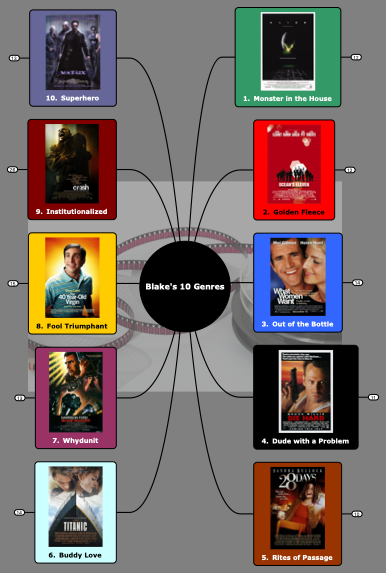Monster in the House
Requirements
- Monster
- House
- Sin
Techniques
- Half Man – This is a survivor who has run into the monster before – or has prior knowledge of the evil – and come away damaged because of it. From a practical screenwriting point of view, the Half Man allows us to reveal the myth of the monster – and give the hero a hint about what dealing with the monster entails. Many of these Half Man characters wind up dying at the “All is Lost” moment on page 75 and are the “flawed mentors” of each story, warning us by their deaths. . . about the horror that awaits.
Must See
- 1979 – Alien
- 1987 – Fatal Attraction
- 1996 – Scream
- 2002 – The Ring
- 2004 – Saw
Golden Fleece
Requirements
- Road
- Team
- Prize
Techniques
- Road Apple – That thing that kyboshes the plan just when victory is in sight.
Must See
- 1976 – The Bad News Bears
- 1987 – Planes, Trains, and Automobiles
- 1998 – Saving Private Ryan
- 2001 – Ocean’s Eleven
- 2004 – Maria Full of Grace
Out of the Bottle
Requirements
- Wish
- Spell
- Lesson
Techniques
- The Rules – So when we screenwriters come up with magic, we need to create a set of boundaries called The Rules.
- Double Mumbo Jumbo – This is a menace and it happens when we pile one empowerment on top of another and makes the story fuzzy.
- Confidant – An ally whom the hero can trust with his secret. There is a practical screenwriting reason for this: the hero has to tell someone – and US – what’s happening.
Must See
- 1976 – Freaky Friday
- 1985 – Cocoon
- 1996 – The Nutty Professor
- 2000 – What Women Want
- 2004 – Eternal Sunshine of the Spotless Mind
Dude with a Problem
Requirements
- Innocent Hero
- Sudden Event
- Life or Death Battle is at Stake
Must See
- 1975 – Three Days of the Condor
- 1988 – Die Hard
- 1991 – Sleeping with the Enemy
- 1998 – Deep Impact
- 2004 – Open Water
Rites of Passage
Requirements
- Life Problem
- Wrong Way (to attack the mysterious problem)
- Solution that involves “acceptance” of a hard truth
Must See
- 1979 – 10
- 1979 – Kramer vs. Kramer
- 1980 – Ordinary People
- 2000 – 28 Days
- 2004 – Napoleon Dynamite
Buddy Love
Requirements
- Incomplete Hero
- Counterpart
- Complication
Techniques
- Two-Hander – If both characters change and grow, it’s called a Two-Hander, meaning that each of the buddies has a set-up and a pay-off.
- Three-Hander – The Three-Hander includes leaving the wrong guy or gal for the right one, as in most Triangle movies (Sweet Home Alabama, Bridget Jones’s Diary, His Gal Friday).
- Four-Hander – This dissects two couples.
Must See
- 1979 – The Black Stallion
- 1987 – Lethal Weapon
- 1989 – When Harry Met Sally
- 1997 – Titanic
- 2005 – Brokeback Mountain
Whydunit
Requirements
- Detective – secret of the case is so strong it overwhelms the hero – we gots to know!
- Dark Turn where detective breaks the rules, even his own – often ones he has relied on for years to keep him safe – the pull of the secret is too great
Techniques
- Turning Over Cards – This movie is only concerned with turning over cards, those “reveals” writers use to explode like time-bombs all along the trail.
- Case within a Case – At the end of the line, the trail doubles back on itself and onto those investigating the crime. This is why the set-up of many detective stories involves one case that seems to end and then has a reappearance as a new case with new players that brings the hero back to the initial escapade in a way we know will address the real problem. This whydunit feature is called the case within a case, and often reveals the theme. By returning to the first caper, and discovering what it means to the detective, we learn what the real story has been about all along.
Must See
- 1976 – All the President’s Men
- 1982 – Blade Runner
- 1996 – Fargo
- 2003 – Mystic River
- 2005 – Brick
Fool Triumphant
Requirements
- Fool
- Establishment
- Transmutation – Fool becomes someone or something new. Fool has a “name change” that’s taken on as either by accident or as a disguise
Techniques
- Insider – Matched against the Fool; this is the “jealous brother” who “gets it,” who knows the Fool has magic powers, sometimes ones that – in the beginning – threaten him. These are the “smart guys” who often pay for their insight by getting the karmic backlash from trying to compete with the fool.
Must See
- 1979 – Being There
- 1982 – Tootsie
- 1994 – Forrest Gump
- 2001 – Legally Blonde
- 2005 – The 40-Year-Old Virgin
Institutionalized
Requirements
- group
- choice
brando / naif vs. company man
sacrifice must be made
join the group
burn it down
commit “suicide”
Techniques
- Brando – This character stands opposed to the system by his very nature. This character stands opposed to the system by his very nature and reveals its flaws.
- Naif – may be the hero – eventually! The character the audience identifies with most because we know nothing of the rules
- Company Man – An automaton entrenched in the system; usually suffers from dysfunction, sexual dysfunction, and/or insanity.
Must See
- 1970 – M*A*S*H
- 1989 – Do the Right Thing
- 1999 – Office Space
- 2001 – Training Day
- 2005 – Crash
Superhero
Requirements
- Special Power and/or Knowledge
- Nemesis
- Curse for the Hero
Techniques
- The Hero either surmounts the curse or succumbs to the curse.
Must See
- 1980 – Raging Bull
- 1994 – The Lion King
- 1999 – The Matrix
- 2000 – Gladiator
- 2004 – Spiderman 2







